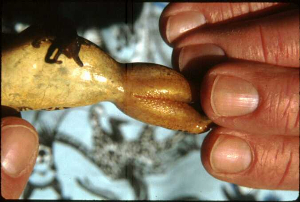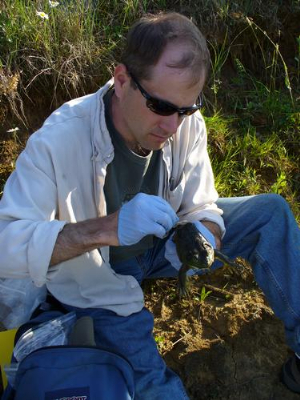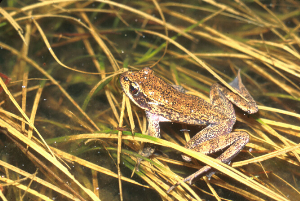Search ARMI Database
Search term(s)
Contribution Number
Search Results
856 record(s) found.
Papers & Reports Exploring extensions to multi-state models with multiple unobservable states.
Authors: Larissa L Bailey; W L Kendall; D R Church
Date: 2008 | Outlet: Environmental and Ecological Statistics 3: 693–709
Papers & Reports Sampling design trade-offs in occupancy studies with imperfect detection: Examples and software.
Authors: Larissa L Bailey; J E Hines; J D Nichols; Darryl I MacKenzie
Date: 2007 | Outlet: Ecological Applications 17: 281-290
Papers & Reports Fire, flow and dynamic equilibrium in stream macroinvertebrate communities
Authors: R S Arkle; David S Pilliod; K Strickler
Date: 2010 | Outlet: Freshwater Biology 55: in press
Papers & Reports Polychlorinated Biphenyls and Toxaphene in Pacific Treefrog Tadpoles (Hyla regilla) from the California Sierra Nevada, USA
Authors: Jeffrey E Angermann; Gary M Fellers; F Matsumura
Date: 2002 | Outlet: Environmental Toxicology and Chemistry 21: 2209–2215
Papers & Reports Ecosystem engineering beaver and the population of Columbia spotted frogs in western Montana
Authors: Stephen J Amish
Date: 2006 | Outlet: Thesis. Missoula: University of Montana
Beavers (Castor canadensis) are ecosystem engineers, altering hydrologic regimes, ecosystem processes, and modifying community structure. How beaver alter landscape patterns of wetlands or lentic habitat (e.g., ponds) and the distribution of obligate species remains an interesting unexamined question. A database of over 100 watersheds in southwestern Montana was used to compare the scale and pattern of lentic habitat and Columbia spotted frog (Rana luteiventris) detection between watersheds with and without signs of beaver presence.
Papers & Reports Association of amphibians with attenuation of ultraviolet-b radiation in montane ponds
Authors: Michael J Adams; D E Schindler; Richard B Bury
Date: 2001-08 | Outlet: Oecologia 128: 519-525
Ambient ultraviolet-b (UV-B) radiation (280 – 320 nm) has increased at north-temperate latitudes in the last two decades. UV-B can be detrimental to amphibians, and amphibians have shown declines in some areas during this same period. We documented the distribution of amphibians and salmonids in 42 remote, subalpine and alpine ponds in Olympic National Park, Washington, USA. We inferred relative exposure of amphibian habitats to UV-B by estimating the transmission of 305 and 320-nm radiation in pond water. We found breeding Ambystoma gracile, A. macrodactylum and Rana cascadae at 33%, 31%, and 45% of the study sites, respectively. Most R. cascadae bred in fishless shallow ponds with relatively low transmission of UV-B. The relationship with UV-B exposure remained marginally significant even after the presence of fish was included in the model. At 50-cm water depth, there was a 55% reduction in incident 305-nm radiation at sites where breeding populations of R. cascadae were detected compared to other sites. We did not detect associations between UV-B transmission and A. gracile or A. macrodactylum. Our field surveys do not provide evidence for decline of R. cascadae in Olympic National Park as has been documented in Northern California, but are consistent with the hypothesis that the spatial distribution of R. cascadae breeding sites is influenced by exposure to UV-B. Substrate or pond depth could also relate to the distribution of R. cascadae in Olympic National Park.
Papers & Reports The short-term effect of cattle exclosures on Columbia Spotted Frog (Rana luteiventris) populations and habitat in Northeastern Oregon, USA
Authors: Michael J Adams; Christopher A Pearl; Brome McCreary; Stephanie K Galvan; S J Wessell; W H Wente; Chauncey W Anderson; A B Kuehl
Date: 2009-03-01 | Outlet: Journal of Herpetology 43: 132-138
Livestock grazing is a common land use across the western USA, but concerns have been raised regarding its potential to affect amphibian populations. We studied the short-term effects of full and partial livestock grazing exclosures on Rana luteiventris (Columbia Spotted Frog) populations using a controlled manipulative field experiment with pre- and post-treatment data (2002-2006). Despite a significant increase in vegetation height within grazing exclosures, we did not find treatment effects for egg mass counts, larval survival, or size at metamorphosis 2-3 years following grazing exclosure installation. Water samples taken in late summer showed concentrations of nitrite, nitrate, ammonia and orthophosphate that were low or near detection limits across all ponds and years. The results of this experiment do not support a hypothesis that limiting cattle access to breeding ponds will help conserve R. luteiventris populations in our study area. Further research is needed to evaluate regional variation and long-term effects of grazing exclosures on R. luteiventris populations.
Papers & Reports Indirect facilitation of an anuran invasion by non-native fishes
Authors: Michael J Adams; Christopher A Pearl; Richard B Bury
Date: 2003-03-13 | Outlet: Ecology Letters 6: 343-351
Positive interactions among non-native species could greatly exacerbate the problem of invasions, but are poorly studied and our knowledge of their occurrence is mostly limited to plant-pollinator and dispersal interactions. We found that invasion of bullfrogs is facilitated by the presence of coevolved non-native fish, which increase tadpole survival by reducing predatory macroinvertebrate densities. Native dragonfly nymphs in Oregon, USA caused zero survival of bullfrog tadpoles in a replicated field experiment unless a non-native sunfish was present to reduce dragonfly density. This pattern was also evident in pond surveys where the best predictors of bullfrog abundance were the presence of non-native fish and bathymetry. This is the first experimental evidence of facilitation between two non-native vertebrates and supports the invasional meltdown hypothesis. Such positive interactions among non-native species have the potential to disrupt ecosystems by amplifying invasions, and our study shows they can occur via indirect mechanisms.
Papers & Reports Problems and opportunities managing invasive Bullfrogs: is there any hope?
Authors: Michael J Adams; Christopher A Pearl
Date: 2007 | Outlet: Gherardi F, editor. Biological invaders in inland waters: Profiles, distribution, and threats. Springer, Dordrecht, The Netherlands.
The American Bullfrog (Rana catesbeiana Shaw) is a widely introduced and invasive anuran that is frequently blamed for population declines of native species (Bury and Whelan 1984). Once established, Bullfrog populations are often either difficult or impossible to eradicate depending on habitat and landscape features (Schwalbe and Rosen 1988, Doubledee et al. 2003, Govindarajulu et al. 2005). Bullfrogs are representative of a large but neglected suite of invasive species that are characterized by: 1) a broad invasion that is well established in some areas; 2) a lack of obvious economic impacts compared to some other invasive species; and 3) a lack of reasonably feasible control methods. Despite demonstrated conservation concerns, invasive species like the Bullfrog do not tend to attract the resources necessary to attempt large scale management because of their lack of economic impact and the difficulty of control methods. This leaves biologists responsible for managing habitats invaded by such species with little hope and few options for promoting the persistence of sensitive native species. With these issues in mind, we consider the case of the Bullfrog, review management options, and suggest directions for future research with this and similar species.
Papers & Reports Tailed frog, Ascaphus truei
Authors: Michael J Adams; Christopher A Pearl
Date: 2005 | Outlet: Lannoo M, editor. Amphibian declines: the conservation status of United States species. Berkeley: University of California Press Pp 382-384
A species account for the Tailed Frog (Ascaphus truei[/])
Papers & Reports Distribution patterns of lentic-breeding amphibians in relation to ultraviolet radiation exposure in western North America
Authors: Michael J Adams; Blake R Hossack; Roland A Knapp; P. Stephen Corn; S Diamond; P Trenham; D Fagre
Date: 2005 | Outlet: Ecosystems 8: 488-500
An increase in ultraviolet-B (UV-B) radiation has been posited as one potential factor in some amphibian population declines. This hypothesis has received support from laboratory and field experiments showing that current levels of UV-B can cause embryo mortality in some species, but little research has addressed whether UV-B is influencing the distribution of amphibian populations. We compared patterns of amphibian presence to site-specific estimates of UV-B dose at 683 ponds and lakes in Glacier, Olympic, and Sequoia-Kings Canyon National Parks. All three parks are located in western North America, a region with a concentration of documented amphibian declines. Site-specific daily UV-B dose was estimated using modeled and field-collected data to incorporate effects of elevation, landscape, and water column dissolved organic carbon. Of the eight species we examined (Ambystoma gracile, Ambystoma macrodactylum, Bufo boreas, Pseudacris regilla, Rana cascadae, Rana leuteiventris, Rana muscosa, Taricha granulosa), two species (T. granulosa and A. macrodactylum) had quadratic relationships with UV-B that could have resulted from negative UV-B effects. Both species were most likely to occur at moderate UV-B levels. Ambystoma macrodactylum only showed this pattern in Glacier National Park. Occurrence of A. macrodactylum increased as UV-B increased in Olympic National Park despite UV-B levels similar to those recorded in Glacier. We also found marginal support for a negative association with UV-B for P. regilla in one of the two parks where it occurred. We did not find evidence of a negative UV-B effect for any other species. Much more work will be necessary to determine if UV-B, either alone or in concert with other factors, is causing widespread population losses in amphibians.
Papers & Reports Batrachochytrium dendrobatidis in amphibian populations in Italy
Authors: Michael J Adams; Stephanie K Galvan; R Scalera; C Grieco; R Sindaco
Date: 2008 | Outlet: Herpetological Review 39: 324-326
We swabbed 45 amphibians and of these, 4 were positive for B. dendrobatidis. We found B. dendrobatidis on all 3 Rana catesbeiana captured in a small farm pond near Turin. Rana catesbeiana is a North America species introduced to Italy more than 50 years ago (Lanza 1962). Out of 41 native amphibians tested, we only found one individual that was positive for B. dendrobatidis. The positive individual was 1 of 10 R. esculenta tested at 5 ponds in Study Area C. We did not find any frogs that were dead or that appeared to be sick.
Papers & Reports Incidence of the fungus Batrachochytrium dendrobatidis in amphibian populations along the northwest coast of North America
Authors: Michael J Adams; Stephanie K Galvan; David Reinitz; R A Cole; S Pyare; M Hahr; Purnima Govindarajulu
Date: 2007 | Outlet: Herpetological Review 38
Of 242 amphibians swabbed, 52 were positive for B. dendrobatidis (Table 1). We found B. dendrobatidis on individuals from 11 of 22 populations and in 3 of the 4 study areas (A, C and D). All but 2 of the positive results were for Bufo boreas adults or juveniles. The other two positives were for Rana aurora adults. No R. luteiventris or R. sylvatica were positive. We did not find any frogs that were dead or appeared to be sick. For populations with at least one positive animal and with N  5 adults and juveniles, the percent of adults and juveniles testing positive averaged 34% and ranged from 10 to 80%.
Papers & Reports Using occupancy models to understand the distribution and prevalence of an amphibian pathogen, Batrachochytrium dendrobatidis
Authors: Michael J Adams; Nathan D Chelgren; David Reinitz; R A Cole; L J Rachowicz; Stephanie K Galvan; Brome McCreary; Christopher A Pearl; Larissa L Bailey; Jamie Bettaso; Evelyn L Bull; M Leu
Date: 2010-01 | Outlet: Ecological Applications 20: 289-302
Batrachochytrium dendrobatidis is a fungal pathogen that is receiving attention around the world for its role in amphibian declines. Study of its occurrence patterns is hampered by false negatives: the failure to detect the pathogen when it is present. Occupancy models are a useful but currently underutilized tool for analyzing detection data when the probability of detecting a species is less than 1. We use occupancy models to evaluate hypotheses concerning the occurrence and prevalence of B. dendrobatidis and discuss how this application differs from a conventional occupancy approach. We found that the probability of detecting the pathogen, conditional on presence of the pathogen in the anuran population, was related to amphibian development stage, day of the year, elevation, and human activities. B. dendrobatidis was found throughout our study area but was only estimated to occur in 53.4% of 78 populations of native amphibians and 66.4% of 40 populations of non-native R. catesbeiana tested. We found little evidence to support any spatial hypotheses concerning the probability that the pathogen occurs in a population, but did find evidence of some taxonomic variation. We discuss the interpretation of occupancy model parameters, when, unlike a conventional occupancy application, the number of potential samples or observations is finite
Papers & Reports The endemic headwater stream amphibians of the American Northwest: associations with environmental gradients in a large forested preserve
Authors: Michael J Adams; Richard B Bury
Date: 2002-04-09 | Outlet: Global Ecology and Biogeography 11: 169-178
We used a large forested preserve (Olympic National Park, USA) to examine the habitat associations of a unique and environmentally sensitive stream amphibian fauna: Ascaphus truei Stegneger, Rhyacotriton olympicus (Gaige), and Dicamptodon copei Nussbaum. We quantified the relative abundance of stream amphibians and compared them to physical, topographic, climatic, and landscape variables. All three species were associated with the southwest to northeast climate gradient; tending to be most abundant in the southwest. Although a habitat generalist relative to the other two species, Dicamptodon copei was absent from the northeastern portion of the park. Ascaphus truei and Rhyacotriton olympicus were both associated with coarse substrates and steep gradients. Unlike studies in harvested forests, all stream amphibians were common in waters with unconsolidated surface geology (e.g., marine sediments that erode easily). Studies of ecological preserves can provide an important baseline for evaluating species associations with environmental gradients and can reveal patterns not evident in more disturbed landscapes.
Papers & Reports Pond permanence and the effects of exotic vertebrates on anurans
Authors: Michael J Adams
Date: 2000-04-01 | Outlet: Ecological Applications 10: 559-568
In many permanent ponds throughout western North America, the introduction of a variety of exotic fish and bullfrogs (Rana catesbeiana) correlates with declines in native amphibians. Direct effects by exotics are suspected to be responsible for the rarity of some native amphibians and are one hypothesis to explain the prevalence of amphibian declines in western North America. However, the prediction that the permanent ponds occupied by exotics would be suitable for native amphibians if exotics were absent, has not been tested. I used a series of enclosure experiments to test whether survival of northern red-legged frog (Rana aurora aurora) and Pacific treefrog (Hyla regilla) larvae is equal in permanent and temporary ponds in the Puget Lowlands, Washington, USA. I also examined the direct effects of bullfrog larvae and sunfish. Survival of both species of native anuran larvae was generally lower in permanent ponds. Only one permanent pond out of six was an exception to this pattern and exhibited increased larval survival rates in the absence of direct effects by exotics. The presence of fish in enclosures reduced survival to near zero for both native species. An effect of bullfrog larvae on Pacific treefrog larval survival was not detected, but effects on red-legged frog larvae were mixed. A hypothesis that food limitation is responsible for the low survival of native larvae in some permanent ponds was not supported. My results confirm that direct negative effects by exotic vertebrates on native anurans occur, but suggest they may not be important to broad distribution patterns. Instead, habitat gradients or indirect effects of exotics appear to play major roles. I found support for the role of permanence as a structuring agent for pond communities in the Puget lowlands, but neither permanence nor exotic vertebrates fully explained the observed variability in larval anuran survival.







